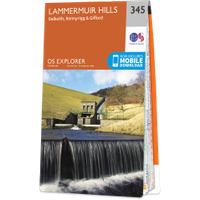

The castle of Schank Place House appears as a substantial building on a plan of the Arniston House estates from 1582.
The drawing shows a tall keep at one corner of a courtyard enclosure, the courtyard enclosing several other buildings, and the wall joining to a smaller round tower with conical roof.
In 1582 or 1586 John Elphinstone of Schank sold five small estates he owned adjoining the Arniston House estate to the owner of that estate, Sir James Dundas and his father George, in exchange for 81 acres of land adjoining Schank.
The grand castle is long gone, but the ruins of a new Shank House, possibly built in the 16th century by the Duke of Argyll or the Earl of Bute, can apparently still be seen, although I haven’t had a chance to visit yet.
They are situated to the west of the south-west wall of a walled garden, and consist of the south-east and south-west walls of a two storey, four bay pink sandstone building.
The walled garden is of some note, being the place where John Reid wrote “The Scots Gard’ner” in 1683.
By the mid-18th century the lands of Shank were owned by William Grant, Lord Prestongrange, and in 1756 the estate passed to Robert Dundas of Arniston upon his marriage to Grant’s third daughter, Jean Grant.
The Shank estate seems to have been sold by the owners of Arniston House in the 1980s, and it is now operated as a market garden (Ballantyne Nursery).
Alternative names for Shank House
Schanckplace; Schank; Shank Place House; Shanks Garden
Where is Shank House?
Shank House is in the parish of Borthwick and the county of Midlothian.
Grid reference: NT 33432 61149
Lat / long: 55.839648, -3.06628











